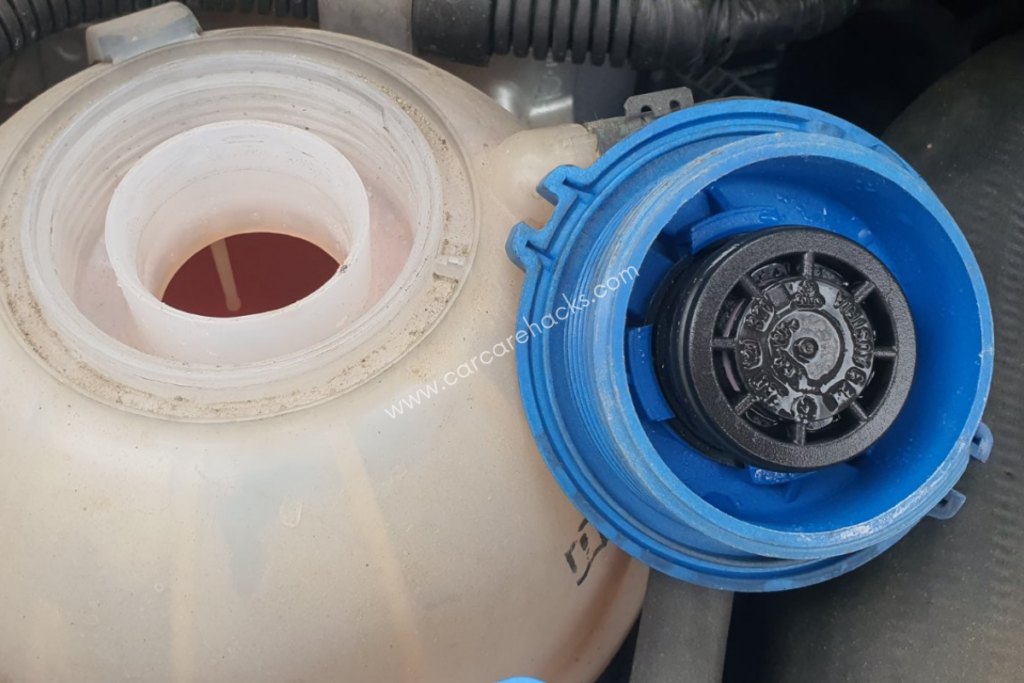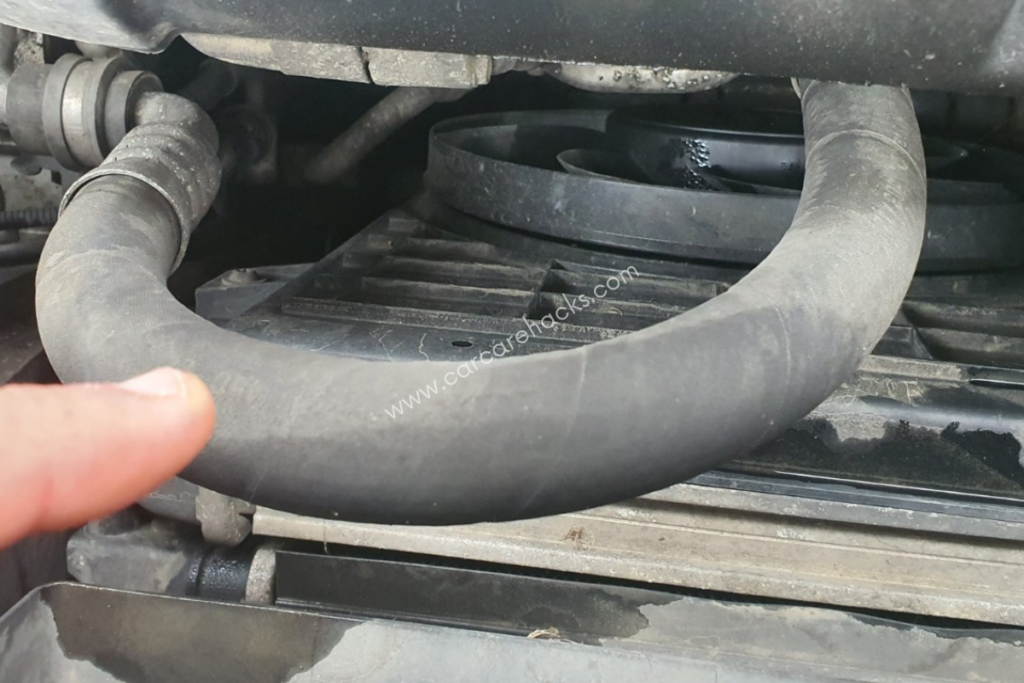Coolant overflow tanks are a part of the cooling system and they play an important role. As we all know, the cooling system has the task to keep the engine running at the optimum working temperature. The combustion process creates heat and the cooling system steps in and prevents the engine from overheating. But, how the coolant overflow tank exactly works? Read on to find out.
Key Takeaway
- The coolant overflow tank allows hot coolant from the engine to cool off before performing another cooling cycle. It releases the extra pressure through the cap and into the atmosphere and prevents any damage to the hoses.
- The hot coolant sits in the overflow tank until it is cooled down. Only then the coolant can be sent back to the radiator.
- There should always be coolant in the overflow tank and there are markings on the side that suggest how much coolant you should put in.
- The coolant overflow tanks are not pressurized and work only by atmospheric pressure.
- When the coolant cools down, it contracts and the atmospheric pressure allows the coolant to return to the radiator.
How The Coolant Overflow Tank Works

The traditional cooling system in many cars has a radiator with a radiator cap that is connected to a coolant overflow tank by a hose. The radiator cap has a vital purpose to keep the pressure in the cooling system at optimal levels and prevent dangerous boiling from occurring.
As combustion occurs, the engine temperature increases. This is when the coolant starts flowing around the combustion chamber and other engine parts and takes the heat away. However, by absorbing the heat, the coolant expands and the pressure builds up. Since the cooling system is pressurized, creating more pressure can lead to damage to the cooling system. This is where the coolant overflow tank comes into play.
The way that the coolant overflow tank works is when the coolant gets hot and expands, the newly created pressure pushes a spring in the radiator cap that opens a seal and allows the hot coolant to get into the overflow tank. In the overflow tank, the coolant will cool down. When the coolant in the overflow tank cools down, atmospheric pressure from the overflow tank will push the cold coolant back into the radiator because the pressure in the overflow tank is actually higher than the one in the radiator.
The overflow tank should be filled up with coolant up to the ”full” marking on the side of the tank. It is designed to be filled up to a certain point. Even so, it can still take more hot coolant coming from the radiator. But also, it is designed when the coolant cools down and gets sucked back into the radiator, no air is getting in the system. There will always be a certain amount of coolant in the overflow tank.
What Is The Purpose of a Radiator Overflow Tank?

The purpose of a radiator overflow tank is to store and cool down the coolant that overflows from the radiator as it gets hotter while circulating around the engine. By storing the hot coolant and cooling it down, the radiator overflow tank actually prevents the cooling system from exploding from high pressure.
If I had to explain the radiator overflow tank to a child, I would say that it is a room where angry people go to cool off before they come back and do their job. When the coolant absorbs the heat from the engine, it gets hot. When things like coolant get hot, they tend to expand. If there is no room to expand, the hoses and probably the radiator itself will explode.
To prevent that, car manufacturers invented the radiator overflow tank. As the coolant gets hot and expands, it creates a pressure of about 16 PSI that opens a seal held in place by the radiator cap and allows the coolant to get inside the radiator overflow tank where it will be cooled down. As the coolant cools down, it goes back inside the radiator for another cooling cycle.
If the radiator overflow tank is damaged or leaking, the whole cooling operation is compromised. The cooling system is pressurized and relies on pressure to circulate the coolant where it needs to be. If there is a leak, the pressure would be lost and there would be no proper circulation of the coolant in the cooling system.
What Happens To Coolant In Overflow Tank?

When the coolant comes into the overflow tank, it gets stored there until it is cooled down enough to go back into the radiator for another cooling cycle. Since there is already cold coolant in the overflow tank, the hot coolant from the radiator gets mixed in order to cool down faster.
Coolant is one of the most important liquids in cars. It helps the engine to stay within the optimal working temperature and avoid overheating. It can get exceptionally hot under the hood. Some types of coolants are designed to reach an optimal temperature ranging from 115 degrees Fahrenheit to 190 degrees Fahrenheit.
To avoid getting the coolant too hot, the cooling system uses a cooling fan to aid in cooling down the engine and coolant, and a water pump to circulate the coolant around the engine. However, the radiator fan alone can’t cool down the coolant. This is why when the coolant reaches a certain temperature and expands, it gets sent to the radiator overflow tank where it will get cooled down.
When the coolant gets cooled down to a certain temperature, it will get sucked from the radiator overflow tank back into the radiator. From there, with the help of a water pump, the freshly cooled coolant will circulate around the engine and cool it down.
This is how the cooling system works and keeps the engine running at the correct temperatures.
Should There Be Coolant In The Overflow Reservoir?

There should always be coolant in the overflow reservoir. In fact, the overflow reservoir should be filled with coolant up to the ”full” marking and not only 30% as many suggest. Filling up the overflow reservoir only 30% can lead to engine overheating because there won’t be enough cold coolant sitting at standby and awaiting to be sent to the engine to cool it down.
Overflow reservoirs work by storing and cooling down hot coolant from the radiator. The overflow reservoirs have markings on the side for both low and high levels. You should always fill the overflow tank with coolant up to the full marking. If you take a closer look, you will notice that there is enough room for more coolant above the ”full” marking.
This means that the overflow reservoir can take more coolant when it is filled up to the ”full” mark. Many so-called mechanics suggest that you should fill the overflow reservoir with only 30%. This is very wrong and can lead to engine overheating.
The overflow tank keeps the coolant and cools it down. When the coolant gets cooled down, it is sent back to the radiator for another cycle around the engine. If the overflow tank is low on coolant, the amount sent back to the radiator will not be sufficient to cool down the engine properly. This is why the markings on the side of the overflow reservoir read low and full.
The Importance of Coolant Overflow Tank Maintenance
Maintaining a coolant overflow tank requires several basic steps. First, ensure the cap of the tank is securely fastened and all hoses connecting to it are free from damage or obstructions. If any hose breaks or becomes clogged, replace it promptly before continuing with maintenance.
Next, inspect the coolant levels. If the tank is overfilled, some of the coolant must be taken out until it reaches the recommended level. Be careful not to overfill as this can damage other components in your system such as radiators and water pumps. Furthermore, use a funnel when adding fresh coolant so no spills occur.
Finally, inspect for any leaks or corrosion around the tank. If there are signs of rust or wear, replace the tank promptly since leaking coolant not only affects performance but could potentially pose a safety hazard when in contact with hot engine parts.
Maintaining your car’s coolant overflow tanks on a regular basis will keep its cooling system functioning optimally. By taking time to check levels, inspect for damage, and replace faulty parts as soon as possible, you’ll avoid costly repairs in the future.
Are Coolant Overflow Tanks Pressurized?

The coolant overflow tank is not pressurized as the rest of the cooling system and it works by atmospheric pressure only. When the hot coolant and the pressure from the radiator come into the overflow tank, the coolant gets cooled down and the excess pressure gets vented through the tank cap.
The coolant expands as it becomes heated and thus creates pressure. So, it is safe to say that the cooling system is pressurized. However, the coolant overflow tanks are designed to cool down the coolant and reduce the pressure. They reduce the pressure by releasing it through the cap. And as the hot coolant gets cooled down, it is sent back to the radiator via atmospheric pressure.
Will Radiator Pull Coolant From Reservoir?

When the coolant gets hot it from circulating and absorbing the heat from the engine, it expands. By expanding, the coolant actually creates pressure. This newly created pressure needs to be released somewhere and the hot coolant needs to be cooled down.
This is where the overflow reservoir comes into play. As the coolant gets hot and creates pressure, this pressure pushes a rod in the radiator cap which allows the hot coolant to escape into the overflow reservoir. In the overflow reservoir, the coolant will cool down and contract.
When the coolant cools down, it loses volume (it contracts). This contraction of the coolant allows for atmospheric pressure to push the cold coolant back into the radiator. So, it is the overflow atmospheric pressure that pushes the coolant back into the reservoir. The radiator does not pull coolant from the overflow tank.
The key takeaway here is that you need to have coolant in your overflow tank. There are markings on the side of the overflow tank. They suggest where the overflow tank should be filled. Just make sure that it is always filled to the ”full” mark.
